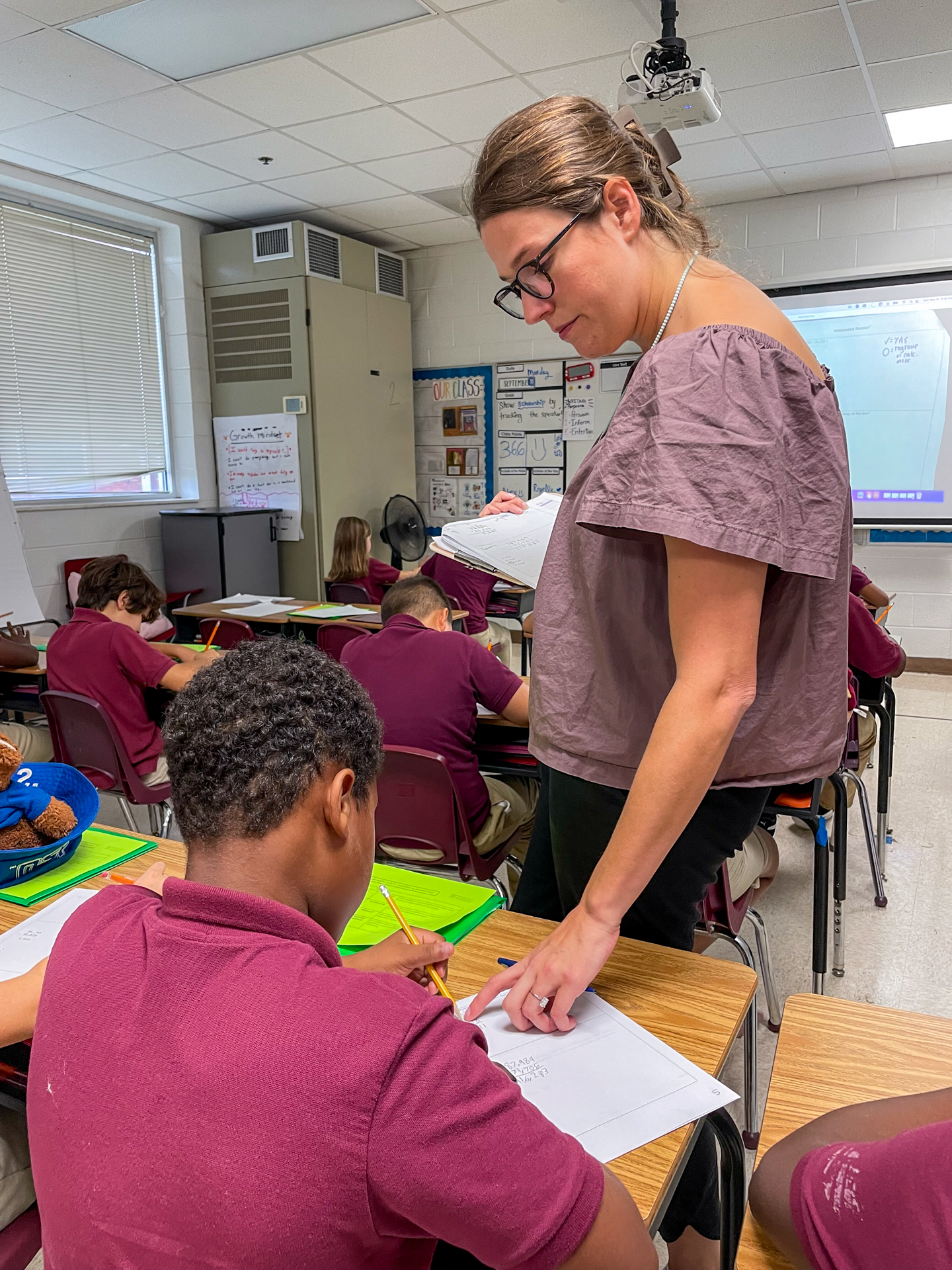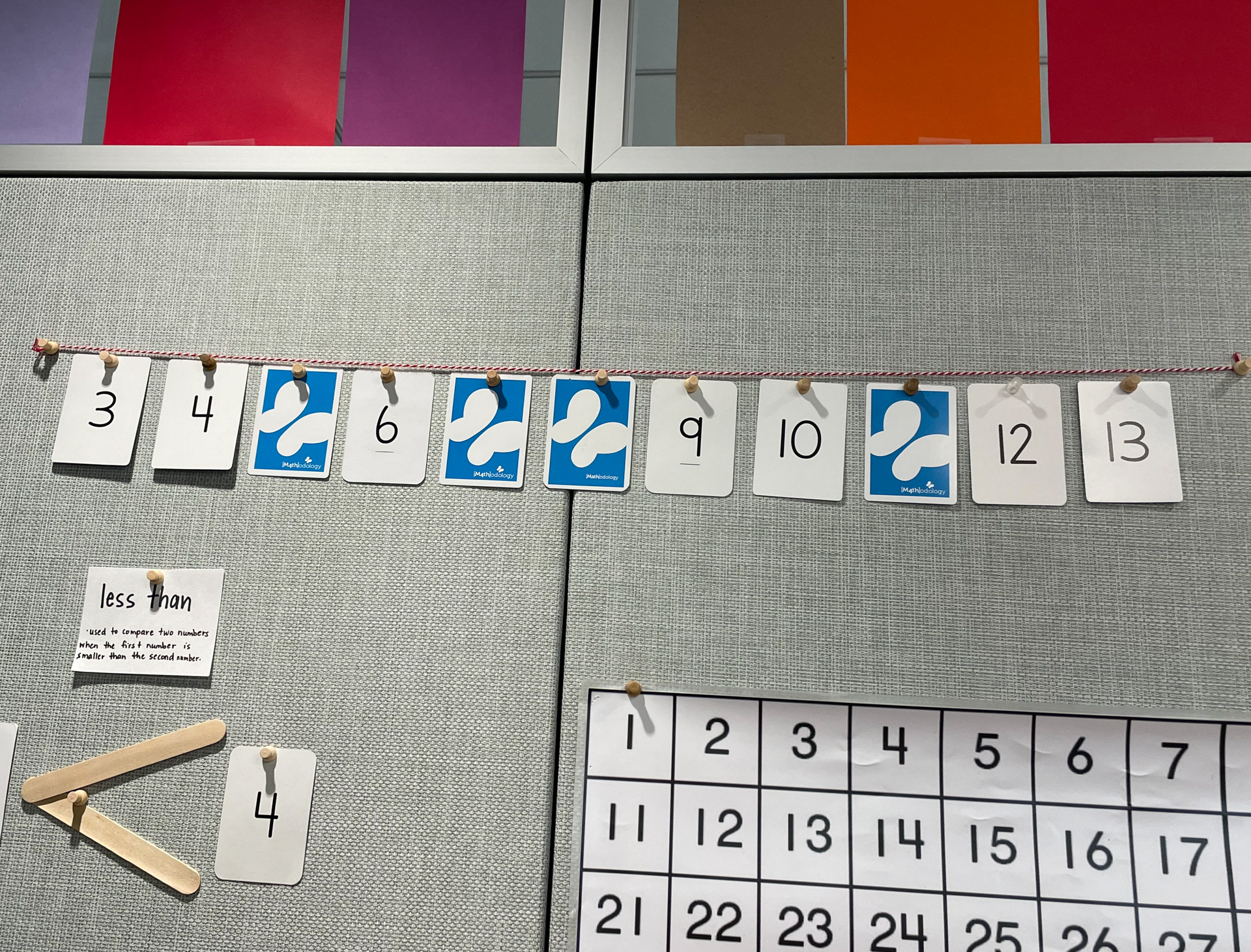Number sense is so innate to many adults that they may not remember being taught such skills. It is crucial to mastering more complex math skills like manipulating fractions and decimals, or solving equations with unknown variables, experts say. Research shows that a flexible understanding of numbers is strongly correlated to later math achievement and the ability to solve problems presented in different ways.
Unlike the recent surge of evidence on science-based reading instruction, research and emphasis on number sense isn’t making its way into schools and classrooms in the same way. Students spend less time on foundational numeracy compared with what they spend on reading; elementary teachers often receive less training in how to teach math effectively; and schools use fewer interventions for students who need extra math support.
Many American students struggle in math. According to the 2024 National Assessment of Educational Progress, nearly 1 in 4 fourth graders and 39 percent of eighth graders scored “below basic,” the test’s lowest category. An analysis of state tests shows that few states have recovered students from pandemic math losses, with disadvantaged students from low-income neighborhoods hit especially hard.
For those struggling students — including those diagnosed with dyscalculia and related learning challenges — lack of number sense often plays a significant role.
“For kids that have a fundamental weakness in mathematics, 80 percent or 90 percent of the time that’s going to be linked to a lack of understanding numbers,” said Ben Clarke, an early math researcher and department head of special education and clinical sciences at the University of Oregon. “If we want students to be able to access other pieces of mathematics that are really important, then they need to build this foundational understanding of numbers.”
Doug Clements, the Kennedy endowed chair in early childhood learning at the University of Denver, said many American students struggle with seeing relationships between numbers. “Children who see 98 plus 99 and line them up vertically, draw a bar underneath with an addition sign, then sum the eight and the nine, carry the one and so forth — they are not showing relational thinking,” Clements said. “Children who immediately say, ‘That’s 200 take away three, so 197,’ are showing number sense.”

Even in the early years of school, researchers can spot students who can make connections between numbers and use more sophisticated strategies to solve problems, just as there are some students who start school already reading.
Also as with reading, gaps between students are present on the first day of kindergarten. Students from low-income and disadvantaged backgrounds arrive at school with less math knowledge than high-income students. Boston College psychologist and early math researcher Elida Laski said research has found income-based differences in how families talk about math with children before they ever reach school.
“Lower-income families are more likely to think about math as narrow, it’s counting and numbers,” Laski said. “Whereas higher-income families tend to think about math as more conceptual and around in everyday life.”
These differences in thinking play out in how flexible students are with numbers in early elementary school. In one study, Laski and her team found that higher-income kindergarten and first grade students used more sophisticated problem-solving strategies than lower-income students, who more often relied on counting. The higher-income students also had more basic math facts committed to memory, like the answer to one plus two.
The memory recall and relatively advanced strategies used by higher-income students produced more efficient problem-solving and more correct answers than counting did. Also, when students from high-income families produced a wrong answer, it was often less wrong than students who were relying on strategies like counting.
Laski said many of the low-income students in the study struggled with addition because they didn’t have a firm understanding of how basic concepts of numbers work. For example, “When we’d ask, ‘What’s three plus four,’ we’d get answers like ‘34,’” Laski said. “Whatever ways they’re practicing arithmetic, they don’t have the conceptual basis to make sense of it. They didn’t have the number sense, really.”
Laski said early childhood classrooms could be “far more direct” with students in teaching number sense, weaving it in explicitly when working on more concrete skills like addition.
Clarke, the early math researcher at University of Oregon, agreed.
“Our understanding has drastically grown in the last 20, 25 years about effective instructional approaches” to help students learn number sense, said Clarke. “If you are only going to get X number of minutes in kindergarten or first grade to support student development in mathematics, kids that are not responding to the core instruction — you have to be pretty focused on what you do and what you offer.”

But elementary school teachers often aren’t trained well on the evidence base for best practices in teaching number sense. A 2022 report from the National Council on Teacher Quality highlights that while teacher training programs have improved in the last decade, they still have a long way to go. By their standard, only 15 percent of undergraduate elementary education programs earned an A for adequately covering both math content and pedagogy.
Teachers aren’t often taught to look at math learning as a whole, a progression of skills that takes students through elementary math, beginning with learning to count and ending up in fractions and decimals — something that some instructional coaches say would help emphasize the importance of how early number sense connects to advanced math. Grade-level standards are the focus that can leave out the bigger picture.
Both the Common Core State Standards and Clements, who served on the 2008 National Mathematics Advisory Panel and helped create a resource of early math learning trajectories, outline those skills progressions. But many teachers are unaware of them.
Instructional coach and math consultant Neily Boyd, who is based in Nashville, Tennessee, said she often works with teachers on understanding how one skill builds on another in sequence, how skills are connected, using the progressions as a jumping-off point.
“When teachers have been trained on both the whole math concept and how the pieces progress from year to year, they’re able to teach their grade-level piece in a way that builds from the previous pieces and towards the future pieces,” she said. “Learning math becomes about widening and refining understandings you’ve already built, rather than a never-ending list of seemingly disconnected components.”
Young students also spend less time with numbers, which often only appear during “math time,” than they do with letters, reading and literacy.
“Often I’ll go into classrooms with literacy stuff all over the walls, but nothing in terms of number,” said Nancy Jordan, professor of learning sciences at the University of Delaware and author of “Number Sense Interventions.” “In the early grades, there are so many ways to build number sense outside of instructional time as well — playing games, number lines in the classroom. Teachers can think of other ways to build these informal understandings of math and relate them to formal understanding.”
On a recent fall day at Nashville Classical Charter School, in Nashville, Tennessee, fourth grade math teacher Catherine Schwartz was walking students through a complicated subtraction problem with big numbers: “Lyle has 2,302 dog treats, but he needs 13,400. How many more treats does Lyle need?”
To solve it, students had to “subtract across zeros,” regrouping from one place value to the next. Subtraction’s standard algorithm is an important skill to learn, Schwartz said, but can’t be done well without strong number sense.
Number sense for older students has some of the same ideas of magnitude and relationships, Schwartz said, but the numbers get bigger. Students began the subtraction problem using 13 thousands and four hundreds to recognize the magnitude of the numbers in each place value, for example, but slowly simplified it into the classic stack-and-subtract method.
Schwartz, who has taught for seven years, said at first she didn’t realize how big a role number sense played in calculations like subtraction with big numbers. ”Number sense or number flexibility, it’s never truly named” in the curriculum, Schwartz said. “We try to practice it.”
Even something as simple as counting big numbers, including hundred thousands and millions, some educators say, can help develop number sense. Counting might seem simple, but for young children it’s foundational and essential. “These are really big ideas for little kids,” Jordan said.
Contact the editor of this story, Christina Samuels, at 212-678-3635 or samuels@hechingerreport.org
You Might Also Like
Research, Curriculum and Grading: New Data Sheds Light on How Professors are Using AI
Kasun is one of an increasing number of higher education faculty using generative AI models in their work. One national...
What Every Parent Should Know About Online Gambling
Since the U.S. Supreme Court removed the legal barriers that had prohibited states from allowing gambling, some 31 now permit...
Education Department Takes a Preliminary Step Toward Revamping Its Research and Statistics Arm
Biedermann said that the Trump administration “absolutely” intends to retain a role in education research, even as it seeks to...
What Schools Stand to Lose in the Battle Over the Next Federal Education Budget
In a news release heralding the legislation, the chairman of the House Appropriations Committee, Republican Tom Cole of Oklahoma, said,...










